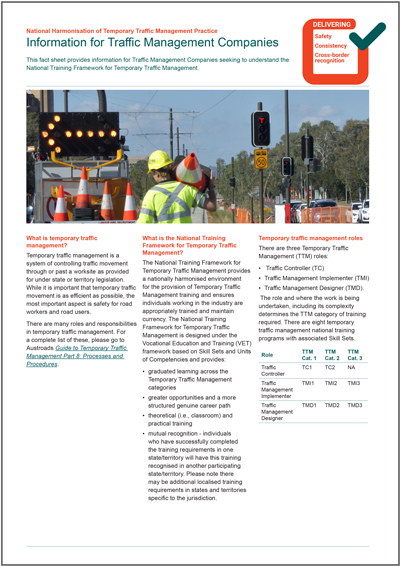Training Requirements
This section outlines the training required for the roles and categories defined in the national harmonisation of temporary traffic management practice.
The national harmonisation of temporary traffic management practice recognises three core roles:
- Traffic Controller
- Traffic Management Implementer
- Traffic Management Designer.
The role and where the work is being undertaken including its complexity determines the temporary traffic management category of training required.
There are eight temporary traffic management national training programs across the core roles and temporary traffic management categories. The programs comprise Skill Sets, Units of Competency, responsibilities of the different parties, and the Austroads temporary traffic management national training material.
Temporary Traffic Management Skill Sets
| Temporary Traffic Management Category 1 | Temporary Traffic Management Category 2 | Temporary Traffic Management Category 3
|
|---|---|---|---|
Traffic Controller
| RIISS00058 - Traffic Controller - Urban Streets and Low Volume Rural Roads (TC1) | Not Applicable | |
Traffic Management Implementer | RIISS00060 - Traffic Management Implementer - Urban Streets and Low Volume Rural Roads (TMI1) | RIISS00061 - Traffic Management Implementer for High Volume Roads (TMI2) | RIISS00062 - Traffic Management Implementer for Motorways and Freeways (TMI3) |
Traffic Management Designer
| RIISS00063 - Traffic Management Designer for Urban Streets and Low Volume Rural Roads (TMD1) | RIISS00064 - Traffic Management Designer for High Volume Roads (TMD2) | RIISS00065 - Traffic Management Designer for Motorways and Freeways (TMD3) |
National Recognition of an Individual’s Temporary Traffic Management Qualifications Across Jurisdictions
Individuals who have achieved a relevant temporary traffic management qualification (i.e. Statement of Attainment) will be nationally recognised across participating states and territories. For example, an individual who has completed the training requirements and holds the Statement of Attainment as a Traffic Controller for category 1 environments from one state can use the same in another state or territory. There may be additional requirements in states and territories specific to the jurisdiction, for example, different personal protective equipment requirements.
This aims to make it easier and more efficient for individuals when moving from one state or territory to another. The standardised national training will assure participating agencies that an individual who is awarded a Statement of Attainment with relevant units of competency can safely perform the relevant temporary traffic management task.
Individual Entry Requirements
Apart from the jurisdictional ‘white card’, there are no entry requirements for individuals who wish to attend a training course to become a Traffic Controller or Traffic Management Implementer for category 1 environments. There are entry requirements to become a Traffic Management Designer working in category 1 environments.
There are also entry requirements before a person can attend a training course to work on more complex category 2 or 3 environments. These entry requirements pertain to the practical experience of an individual. This aims to achieve a nationally consistent set of training entry conditions and ensure only people with appropriate qualifications and experience can be trained in the more complex temporary traffic management environments.
Theory and Practical Learning
An individual will be required to undergo theory (in-class/face-to-face) training, based on a defined set of units of competency per training course and successful assessment before being permitted to undertake the practical learning experience.
After successfully completing theory training, individuals will be required to obtain practical learning experience and successful assessment before being approved. The change aims to ensure that individuals have the opportunity to gain sufficient practical experience before working independently.
The introduction of this graduated training approach, which requires individuals to build up their skills and experience before they undertake qualifications to work in more complex environments, will also enhance safety.
Updated 13 June 2023


